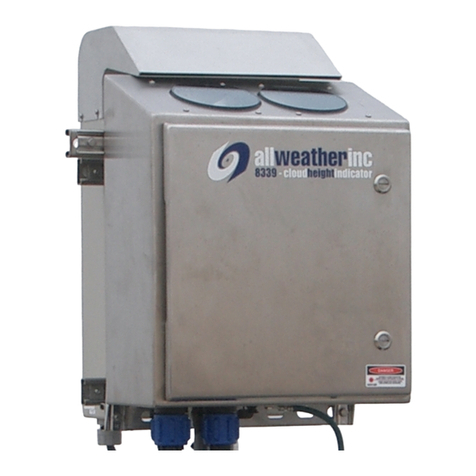Model 2030 Micro Response Anemometer User's Manual
3
Example:
If there is a building 10 meters high and 50 meters away, the anemometer should be at least 16.7
meters above the ground. But, if the same building is 200 meters away, the sensor could be
lowered to 12.5 meters.
When the sensor is mounted on a building, the building itself disturbs the wind flow and must be
taken into account before installation. For large buildings, other than buildings such as
lighthouses and skyscrapers, the sensor must be mounted as far away from the edge of the
building as possible and at a height at least ¾ the height of the building. Thus, with a building
28 meters high, a rooftop tower at least 21 meters high should be used.
2.3 MOUNTING
The Model 2030 Micro Response Contact Anemometer mounts directly to the Model 2023
Crossarm without any additional accessories. The crossarm is generally used to mount one each
Model 2030 Anemometer and a Model 2020 Vane to form a wind speed and direction
measurement set. If the Model 2030 Anemometer is to be mounted separately, a Model 20231
Mast Adapter should be ordered as an accessory. Both the Model 2023 Crossarm and the Model
20231 Mast Adapter will mount on a mast with an outside diameter of 1" (25.4 mm) or ¾"
Schedule 40 pipe. Set screws are provided in either case for securing to the mast. The lower part
of the anemometer body will slip over the pin on the crossarm or the mast adapter. When in
place, tighten all mounting screws.
For AWOS installations, refer to the 2020/2030 AWOS Mounting figure in the Drawings
chapter of this manual.
2.4 ORIENTATION
The anemometer should be mounted with its axis as close to vertical as possible to provide for
the best measurement of horizontal wind movement. If the sensor must be removed from the
mounting adapter or crossarm, loosen only the Allen head screw on the sensor base and slide the
sensor off the adapter. Do not remove the mounting pin from the crossarm or the mast adapter
from the mast since these serve to maintain sensor alignment.




























